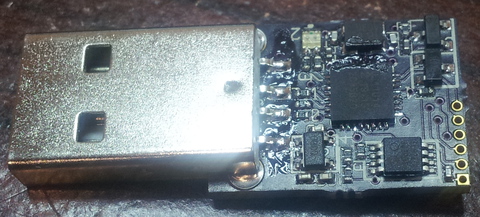This is a hardware True Random Number Generator that attaches via USB.
Version 0.3
This one uses the better noise source coupled with an op amp that provides 2MHz of bandwidth at a gain of 100, offering linear frequency response at a million samples per second.
A photo of prototype version 0.3:

Here’s a circuit diagram of the noise source:
Version 0.3 Hardware
- STM32F042 System-on-Chip
- ARM Cortex-M0 MCU
- 32k Flash
- 6k RAM
- USB 2.0 Full Speed
- Crystal-less operation
- 20V noise source
- AP3015A boost regulator
- back-to-back 3904 transistor noise
- OPA356 op amp
- 200MHz GBP
Version 0.2
This version uses a better noise source, but the single transistor amp designed to get from the 20mV noise source to a digital value doesn’t provide enough bandwidth, so the resulting signal seen by the CPU has poor frequency response.
Here’s a photo of prototype version 0.2:

Version 0.2 Hardware
- STM32F042 System-on-Chip
- ARM Cortex-M0 MCU
- 32k Flash
- 6k RAM
- USB 2.0
- Crystal-less operation
- 20V noise source
- AP3015A boost regulator
- back-to-back 3904 transistor noise
Version 0.1
These are photos of prototype version 0.1:


Version 0.1 Hardware
- NXP LPC11U14 System-on-Chip
- ARM Cortex-M0 MCU
- 32k Flash
- 6k RAM
- USB 2.0
- 8 12-bit analog inputs
- I2C, SPI, async serial
- digital I/O
- ZXRE1004 zener diode noise source
- MCP6L92 dual op-amp
Software
- Firmware Features
- AltOS is written mostly in C with some ARM assembler
- Tools Used
- gEDA for schematic capture and PCB layout
- GCC compiler and source debugger
- Licenses
- The hardware is licensed under the TAPR Open Hardware License
- The software is licensed GPL version 2
Source:https://altusmetrum.org/

Working as a cyber security solutions architect, Alisa focuses on application and network security. Before joining us she held a cyber security researcher positions within a variety of cyber security start-ups. She also experience in different industry domains like finance, healthcare and consumer products.











